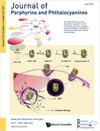新型潜在卟啉光敏剂介导的SH-SY5Y细胞光疗机制及TMeQ[6]自组装在治疗中的作用
IF 0.9
4区 化学
Q4 CHEMISTRY, MULTIDISCIPLINARY
引用次数: 0
摘要
卟啉ps具有较高的光敏性和稳定性,在光疗中有着广泛的应用。此外,使用Q[n]s作为ps的载体有助于提高光动力治疗的疗效。在本研究中,我们合成了由TMeQ[6]和5,10,15,20 -四(4-吡啶基,n -丙基氨)卟啉衍生物(TPPPA)组成的2TMeQ[6]-TPPPA自组装化合物(以2:1的比例),研究其产生活性氧(ROS)的能力以及与TMeQ[6]自组装对人神经母细胞瘤细胞系(SH-SY5Y)疗效的影响。我们的研究结果表明,TPPPA和2TMeQ[6]-TPPPA在激光照射下都会产生大量的活性氧,并且与照射时间成正比。此外,MTT实验表明,这两种化合物对SH-SY5Y细胞都有显著的细胞毒性作用。Western blotting结果显示Cleaved caspase-3、Cleaved caspase-9、Bax的表达明显升高,Bcl-2的表达明显降低,证实了TPPPA光动力治疗诱导SH-SY5Y细胞死亡与caspase依赖性凋亡有关。ROS过剩在这一过程中起着至关重要的作用,NAC预处理被证明可以降低细胞毒性并抑制促凋亡蛋白分子。然而,在与TMeQ[6]自组装后,2TMeQ[6]-TPPPA在ROS生产能力和对SH-SY5Y细胞的毒性方面不如TPPPA有效。综上所述,我们的研究探讨了TPPPA可以诱导ROS过量产生导致细胞凋亡,其介导的光动力治疗是SH-SY5Y细胞的一种非常有效的治疗选择。TPPPA与TMeQ[6]自组装后,保留了其诱导凋亡途径的特性,并充当了载体,但这不利于TPPPA的光动力增强。本文章由计算机程序翻译,如有差异,请以英文原文为准。
The mechanism of novel potential porphyrin photosensitizer mediated phototherapy in SH-SY5Y cell lines and the effect of TMeQ[6] self-assembly in therapy
Porphyrin PSs, possessing high photosensitivity and stability, have widespread use in phototherapy. Furthermore, the use of Q[n]s as a carrier for PSs has contributed to enhancing the efficacy of photodynamic therapy. In the present study, we synthesized 2TMeQ[6]-TPPPA self-assembled compounds, comprising TMeQ[6] and 5, 10, 15, 20-tetra (4-pyridyl, N-propyl ammonia) porphyrin derivatives (TPPPA) (in a 2:1 ratio), to investigate their capacity to generate reactive oxygen species (ROS) and their effect of self-assembly with TMeQ[6] on the efficacy of human neuroblastoma cell line (SH-SY5Y). Our results demonstrate that both TPPPA and 2TMeQ[6]-TPPPA generate substantial amounts of ROS under laser irradiation, which is directly proportional to the duration of illumination. Furthermore, both compounds exhibited significant cytotoxic effects on SH-SY5Y cells, as demonstrated by the MTT assay. Western blotting revealed a marked increase in the expression of Cleaved caspase-3, Cleaved caspase-9, and Bax, and a decrease in the expression of Bcl-2, confirming that caspase-dependent apoptosis is involved in SH-SY5Y cell death induced by TPPPA photodynamic therapy. ROS overproduction plays a crucial role in this process, and NAC preconditioning was shown to reduce cytotoxicity and inhibit pro-apoptotic protein molecules. However, 2TMeQ[6]-TPPPA was less effective than TPPPA in terms of ROS production capacity and toxicity to SH-SY5Y cells after self-assembling with TMeQ[6]. In conclusion, our study explored that TPPPA can induce ROS overproduction leading to apoptosis, and its mediated photodynamic therapy is a highly effective treatment option for SH-SY5Y cells. After self-assembling with TMeQ[6], TPPPA retains its apoptotic pathway-inducing characteristics and acts as a carrier, but this is not conducive to the photodynamic enhancement of TPPPA.
求助全文
通过发布文献求助,成功后即可免费获取论文全文。
去求助
来源期刊
CiteScore
2.10
自引率
20.00%
发文量
62
审稿时长
1 months
期刊介绍:
The Journal of Porphyrins and Phthalocyanines (JPP) covers research in the chemistry, physics, biology and technology of porphyrins, phthalocyanines and related macrocycles. Research papers, review articles and short communications deal with the synthesis, spectroscopy, processing and applications of these compounds.

 求助内容:
求助内容: 应助结果提醒方式:
应助结果提醒方式:


